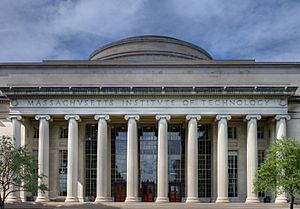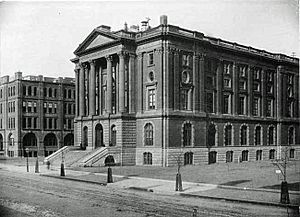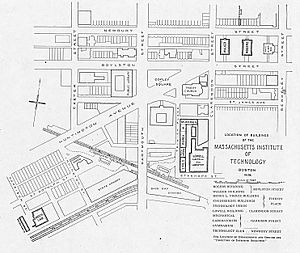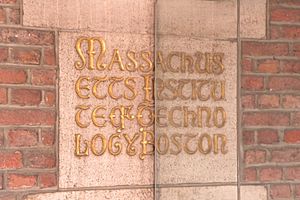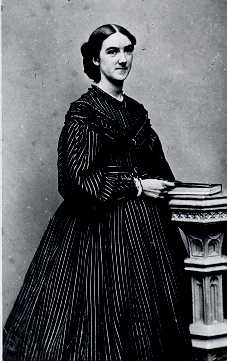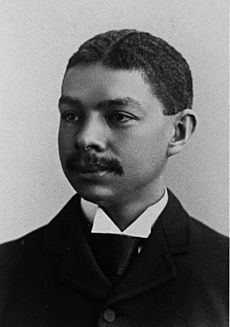History of the Massachusetts Institute of Technology facts for kids
The Massachusetts Institute of Technology, or MIT, is a super famous university known for science and technology. Its story began way back in 1861. A scientist named William Barton Rogers helped create it, along with the "Massachusetts Institute of Technology and Boston Society of Natural History."
Contents
How MIT Began
In 1859, people in Massachusetts suggested using new land in Boston for a museum and a school for art and science.
On April 10, 1861, the governor of Massachusetts signed a special paper. This paper officially started the "Massachusetts Institute of Technology and Boston Society of Natural History." William Barton Rogers, a natural scientist, was the main person behind this idea. Rogers wanted to create a new kind of higher education. He felt that older schools weren't ready for the fast changes happening in science and technology in the mid-1800s.
After the school was approved, Rogers started raising money. He also planned what students would learn and looked for a good place for the school. His plan, known as the Rogers Plan, had three main ideas:
- Learning useful things is important.
- "Learning by doing" is key.
- Mixing professional and general education for college students.
MIT was one of the first schools to use labs for teaching. Its main idea was to teach the scientific rules behind things, not just how to do them.
The American Civil War started just two days after MIT was approved. This made it very hard for Rogers to get money. Because of this, finding teachers and students was delayed. But finally, MIT's first classes were held in rented rooms in downtown Boston in 1865.
Early Years in Boston (1865–1916)
The first MIT building was finished in Boston's Back Bay in 1866. People called the school "Boston Tech" until it moved across the Charles River to Cambridge in 1916.
In 1875, MIT's second president, John Daniel Runkle, saw something amazing at an exhibition. He was impressed by a Russian teacher, Victor Della-Vos. This teacher combined hands-on learning with classroom lessons. Runkle brought this idea to MIT.
MIT faced money problems after 1875. Student numbers dropped, and by 1878, the school had to cut some teaching jobs. There was even talk of closing the school. In 1879, Runkle stepped down as president. The school's leaders asked William Barton Rogers, the founder, to come back as president for a short time.
In 1881, Francis Amasa Walker became MIT's new president. He was a great choice because he had a lot of experience. Sadly, Rogers passed away during Walker's first graduation ceremony in 1882. His last words were famously "bituminous coal".
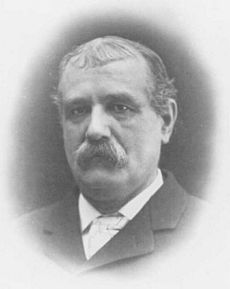
President Walker added new subjects like economics, history, and languages. He also made the school's organization better. He created a special committee to handle daily tasks. Walker also made sure teachers had a say in important decisions.
MIT had trouble getting enough money because Harvard University had a similar science school. People often chose to give money to Harvard instead of the younger MIT. Even though Harvard wanted to combine with MIT many times, MIT always wanted to stay independent.
Walker worked hard to get money from the Massachusetts government. In 1887, the government gave MIT $300,000. This helped the school grow a lot.
MIT's campus in Boston was getting too small. Walker wanted to build new buildings. He started building even before all the money was raised, hoping it would encourage people to donate. The new building in 1883 had excellent labs. More buildings were added later. New study programs were also started under Walker, like Electrical Engineering (1882) and Chemical Engineering (1888).
Walker also worked to make student life better. He supported building a gym and dorms. He also made changes to classes, like reducing homework and making exams shorter. He started summer classes and new master's and doctoral programs. These changes helped MIT grow a lot. Between 1881 and 1897, the number of students quadrupled from 302 to 1,198.
Over the years, MIT's science and engineering classes became more focused on practical skills. Harvard kept trying to merge with MIT. A plan to merge in 1914 was announced, but it was canceled in 1917 by a court decision. MIT has always managed to stay its own independent school.
MIT was the first university in the U.S. to have programs in many fields. These include architecture (1865), electrical engineering (1882), and even artificial intelligence (1960s).
World Wars and Beyond (1917–1939)
During World War I, the United States Navy needed pilots. Commander Jerome Clarke Hunsaker, who had studied and taught at MIT, suggested that MIT start the Navy's first ground school for pilot training.
The first group of 50 student pilots arrived on July 23, 1917. They had an eight-week program learning about electricity, signals, navigation, and airplane parts. MIT provided the training and housing. New classes started every two weeks. By January 1919, over 3,600 students had graduated, ready for flight training.
MIT's ground school became a model for other schools. The naval aviation training at MIT also grew to include a school for weather forecasters and a school for airplane inspectors.
Cold War and Space Race (1940–1966)
MIT changed a lot because of its military research during World War II. The school's Vice President, Vannevar Bush, led a big government research group. This group was even involved in the Manhattan Project, which developed the atomic bomb. Government research helped MIT's research staff and buildings grow a lot. It also shifted the focus from college students to graduate studies.
The MIT Radiation Laboratory helped a lot in developing radar technology. During World War II, MIT was one of many schools that helped train Navy officers.
New Departments Emerge
As the Cold War and Space Race became more intense, people worried about the U.S. falling behind the Soviet Union in technology. Because of this, MIT started new departments in 1957. These included the Department of Nuclear Engineering and the Center for International Studies. In 1951, the first computer programming course was taught at MIT.
Focus on Humanities
For many years, there was a debate about how much humanities and social studies should be taught at MIT. These subjects include economics, history, and political science. Over time, these departments grew and changed.
In 1950, a School of Humanities was created, allowing students to get degrees in these subjects. Since 1975, all MIT college students have to take eight classes in humanities, arts, and social sciences to get their degree.
Social Changes and Activism (1966–1980)
Women at MIT
MIT has always allowed both male and female students. Ellen Swallow Richards was the first female student in 1870. For a long time, there were only a few female students because there were no dorms for them. This changed in 1964 when the first women's dorm, McCormick Hall, was built. It was funded by Katherine Dexter McCormick, an MIT graduate. By 2013, women made up 45% of college students and 31% of graduate students.
Student Protests
In the late 1960s and early 1970s, students and teachers protested against military research at MIT. These protests were so strong that MIT had to separate some of its labs. These labs became the Draper Laboratory and MIT Lincoln Laboratory.
Course "Bibles"
In 1970, a book called The Hidden Curriculum talked about how students at MIT learned. It said that unofficial study guides, called "course bibles" (old homework and solutions), were very important. These "bibles" sometimes made professors think students were learning more broadly than they were.
New Programs and Ideas
Many new programs started during this time:
- MIT and Wellesley College began a program in 1968 where students could take classes at both schools.
- The Undergraduate Research Opportunities Program (UROP) started in 1969. This program lets college students do real research.
- The Mechanical Engineering department started a robotics competition class.
- A program for Health Sciences and Technology began in 1970.
- The Independent Activities Period (IAP) was first offered in 1971. This is a special time in January for unique classes and projects.
- The Council for the Arts was founded in 1972.
- A program in Science, Technology, and Society started in 1977.
Changing Roles and Priorities (1980–2004)
Faculty Diversity
MIT has allowed women to study there since 1870. Ellen Swallow Richards was not only the first female student but also the first female teacher at MIT. For many years, there were very few women students. This changed after the first women's dorm, McCormick Hall, was built in 1963. By 1993, 32% of MIT's college students were female. By 2006, this number was almost half (47.5%).
A study in 1998 looked at how female teachers were treated in the science department. Since then, the number of women students and graduate students has grown a lot. More women are also leading departments in science and engineering. In 2004, Susan Hockfield became MIT's 16th president, and she was the first woman to hold this important job. While there are more women students now, women are still a smaller group among the teachers.
Global Connections and New Ideas (2000–Present)
- In 2000, MIT added a new rule: all college students must show good speaking and writing skills to graduate.
- In 2001, MIT started its OpenCourseWare project. This project puts many of MIT's course materials online for free. By 2010, over 2,000 courses were available to everyone.
- Nicholas Negroponte from the MIT Media Lab helped start the One Laptop per Child project. This project aimed to give low-cost laptops to children around the world.
- Susan Hockfield started the MIT Energy Research council. This group explores how MIT can help solve global energy problems.
- Older programs like Ocean Engineering joined with Mechanical Engineering. New interdisciplinary departments also appeared, like Biological Engineering.
- MIT started working with universities in other countries, like the University of Cambridge in England and schools in Singapore.
- In 2016, MIT opened the MIT Hong Kong Innovation Node.
- In 2021, MIT officially recognized that its campus is on the traditional land of the Wampanoag nation. They honored and respected the many Indigenous people connected to this land.
|


